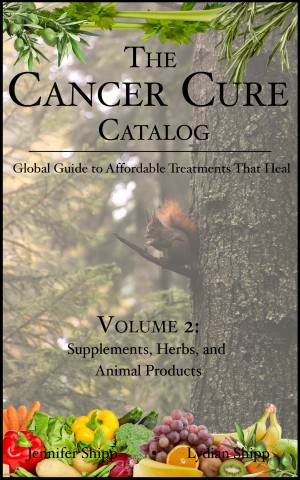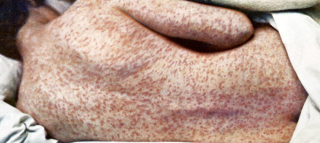Childhood Viral Infections and Quassia amara as an Herbal Remedy for Fever / Herbal Remedy for Measles and Other Serious Viral Infections
Quassia amara, also known as bitterwood, amargo bark, or pau-tenente, is a powerful herb for reducing fever naturally. All parts of the plant are useful, but in this discussion, we’re going to introduce Quassia amara as an herb that can be used as an herbal remedy for measles, smallpox, fever, and and common childhood illnesses and symptoms. Quassia amara is a bush that can be used as an extract of leaves, wood, or bark. It is often used traditionally for digestive issues, liver problems, malaria infection, or as a natural insect repellent, but it is a versatile treatment and one that's often used for skin rash infections. Recently, scientific studies have shown that the extracts of Quassia amara are active against both cancer and HIV.Medicinally, Quassia amara is famous as an herbal remedy for all of the following:
- Fever
- Poor digestion / upset stomach
- Lack of appetite
- Stomach and intestinal disorders
- Anorexia nervosa
- Measles
- Smallpox
- Malaria
- Diarrhea
- Dysentery
- Urinary Tract Infection / UTI
- Low stomach acid
- Poor bile production
- Cirrhosis
- Liver disease
- Diabetes
- Alcoholism
- Albuminaria
- Constipation
- Lice
- Skin conditions
- Parasites / vermifuge
- Anemia
- Blood purifications
- Common cold (decoction)
- Infection
- Amoebic infection
- Leishmaniasis
- Chronic pain
- Inflammation
- Gastric ulcer
- Contraception
- Sedation
- Snakebite
- HIV
- Cancer
- Leukemia
- Carcinomas
- Cancerous tumors

Click here to buy Quassia amara extract.
Quassia amara Medicinal Substances:
Quassimarin is a bitter substance that is present in all parts of the Quassia amara plant, but Quassia amara contains a number of medicinal substances that are currently be studied scientifically including:- Alkaloids
- Indoles
- Beta-Carbonite
- Steroids
- Beta-sitosterol
- Beta-sitosterone
- Camp sterol
- Stigmasterol
- Triterpenes
- Quassinoids (make up about 0.25% of the lant)
- Quassimarin
- Quassinol
- Quassol
- Neoquassine
- Quassine
- 18 hydroxy-quassia
- Quasimetric
- Similikalactone D
- Vitexin
- Brucein D
- Beta-carbonite
- Volatile oils
- Malic acid
- Gallic acid
- Calcium tartrate
- Potassium acetate
- Iroquoian
- Parian

Click here to schedule a health coaching call with us.
Quassia amara Dose:
Quassia amara can be administered orally at a dose of 100 to 500 mg/kg body weight of the patient.
Patients with type 2 diabetes mellitus who are mildly to moderately “fragile” should begin treatment with three 500 mg capsules daily (taken throughout the daily), filled with the heartwood of Quassia amara.
Resources:
• Husain, G. M. et al. (2011). Antidiabetic activity of standardized extract of Quassia amara in nicotinamide-streptozotocin-induced diabetic rats. Retrieved March 17, 2025 from https://pubmed.ncbi.nlm.nih.gov/21480415/
• European Medicines Agency (2009). Assessment report on Arctium lappa L., radix. Retrieved March 17, 2025 from https://www.ema.europa.eu/en/documents/herbal-report/final-assessment-report-arctium-lappa-l-radix_en.pdf
• Ferreira, S. F. et al. (2013). Anti-hiperglycemic effect of Quassia amara (Simaroubaceae) in normal and diabetic rats. Retrieved March 17, 2025 from https://www.scielo.br/j/rbpm/a/QYmhzwbrRhjCyGVS6LWbxtF/
• Olugbogi, E. A. et al. (2022). Quassia amara bioactive compounds as a Novel DPP-IV inhibitor: an in-silico study. Retrieved March 17, 2025 from https://bnrc.springeropen.com/articles/10.1186/s42269-022-00890-1
• Ogbonnaya, K. P. et al. (2024). Evaluation of the Blood Glucose-Lowering Effect of the Aqueous Leaf Extract of Quassia amara L. (Simaroubaceae) on Alloxan-induced Diabetes in Male ICR Mice (Mus musculus). Retrieved March 17, 2025 from https://actamedicaphilippina.upm.edu.ph/index.php/acta/article/view/10852
• Balkrishna, A. et al. (2022). Quassia amara L.: A Comprehensive Review of its Ethnomedicinal Uses, Phytochemistry, Pharmacology and Toxicity. A Retrieved March 17, 2025 from https://www.phytopharmajournal.com/Vol11_Issue3_10.pdf
• Guilherme, S. et al. (2020). Application of Pau-tenente (quassia Amara L.) as Hop Replacement in Brazilian Low-Bitter Beer. Retrieved March 17, 2025 from https://www.cetjournal.it/index.php/cet/article/view/CET2079056
• Bleyer, A. (1926). Enlargement of the Spleen in Measles. Retrieved March 18, 2025 from https://jamanetwork.com/journals/jamapediatrics/article-abstract/1174240
• Slifka, M. K. et al. (2003). Measles virus infection results in suppression of both innate and adaptive immune responses to secondary bacterial infection. Retrieved March 18, 2025 from https://pmc.ncbi.nlm.nih.gov/articles/PMC153759/
• Chapman, J. et al. (2023). Splenomegaly. Retrieved March 18, 2025 from https://www.ncbi.nlm.nih.gov/books/NBK430907/
• No Author (1999). Clinical Features of Smallpox (chapter) taken from Assessment of Future Scientific Needs for Live Variola Virus. Retrieved March 18, 2025 from https://www.ncbi.nlm.nih.gov/books/NBK230904/#:~:text=The%20likely%20sites%20for%20viral,blood%20is%20largely%20cell%2Dassociated.
Medicinally, Quassia amara is famous as an herbal remedy for all of the following:

Quassia amara can be administered orally at a dose of 100 to 500 mg/kg body weight of the patient.
Patients with type 2 diabetes mellitus who are mildly to moderately “fragile” should begin treatment with three 500 mg capsules daily (taken throughout the daily), filled with the heartwood of Quassia amara.
Resources:
• Toma, W. et al. (2003). Evaluation of the analgesic and antiedematogenic activities of Quassia amara bark extract. Retrieved March 18, 2025 from https://www.researchgate.net/publication/10910294_Evaluation_of_the_analgesic_and_antiedematogenic_activities_of_Quassia_amara_bark_extract
• Diehl, C. et al. (2016). Novel antibacterial, antifungal and antiparasitic activities of Quassia amara wood extract. Retrieved March 18, 2025 from https://www.semanticscholar.org/paper/Novel-antibacterial%2C-antifungal-and-antiparasitic-Diehl-Reznichenko/826efec68067cb4533fe00c0ad419b1888ba2868
• Brazil, M. (2004). Nicotine goes into septic shock. Retrieved March 18, 2025 from https://www.nature.com/articles/nrd1586#:~:text=Well%20known%20for%20being%20a%20mild%20stimulant%2C,according%20to%20research%20published%20in%20Nature%20Medicine.&text=The%20'nicotinic%20anti%2Dinflammatory%20pathway'%20could%20explain%20the,suggests%20therapeutic%20potential%20for%20other%20inflammatory%20disorders.
• Matsuda, A. et al. (2012). Novel therapeutic targets for sepsis: regulation of exaggerated inflammatory responses. Retrieved March 18, 2025 from https://pubmed.ncbi.nlm.nih.gov/22398786/
• No Author (n.d.) Lobelia inflata. Retrieved March 18, 2025 from https://www.sciencedirect.com/topics/pharmacology-toxicology-and-pharmaceutical-science/lobelia-inflata#:~:text=Traditionally%2C%20Lobelia%20inflata%20has%20been,of%20the%20potency%20of%20nicotine).
• Stegemann, A. and Bohm, M. (2020). Targeting the alpha-7 nicotinic acetylcholine receptor-A novel road toward the future treatment of skin diseases. Retrieved March 18, 2025 from https://pubmed.ncbi.nlm.nih.gov/32780438/
• Das, R. C. et al. (2023). Antiviral activities of ginseng and its potential and putative benefits against monkeypox virus: a mini review. Retrieved March 18, 2025 from https://pmc.ncbi.nlm.nih.gov/articles/PMC10065872/
• NIH. (1999). Clinical Features of Smallpox. Retrieved March 18, 2025 from https://www.ncbi.nlm.nih.gov/books/NBK230904/
• PAHO (n.d.). Yellow Fever. Retrieved March 18, 2025 from https://www.paho.org/en/topics/yellow-fever#:~:text=Once%20contracted%2C%20the%20yellow%20fever,die%20within%207%20%2D%2010%20days.
• Massoma, A. et al. (2024). Prospects of Carica papaya in the treatment of human viral infections: A comprehensive and a systematic review. Retrieved March 18, 2025 from https://www.cell.com/heliyon/pdf/S2405-8440(24)15666-6.pdf
• Baron, S. et al. (1996). Viral Pathogenesis. Retrieved March 20, 2025 from https://www.ncbi.nlm.nih.gov/books/NBK8149/
• Shoyshob, T. Z. et al. (2024). Protective Mechanisms of Carica papaya Leaf Extract and Its Bioactive Compounds Against Dengue: Insights and Prospects. Retrieved March 20, 2025 from https://www.mdpi.com/2673-5601/4/4/37
• Badilla, B. et al. (1998). Actividad gastrointestinal del extracto acuoso bruto de Quassia amara (Simarubaceae). Retrieved March 21, 2025 from https://www.scielo.sa.cr/scielo.php?script=sci_arttext&pid=S0034-77441998000200003
• Raji, Y. and Oloyede, G. K. (2011). Antiulcerogenic Effects and Possible Mechanism of Action of Quassia amara (L. Simaroubaceae) Extract and Its Bioactive Principles in Rats. Retrieved March 21, 2025 from https://pmc.ncbi.nlm.nih.gov/articles/PMC3746530/
• Diehl, C. and Ferrari, A. (2013). Efficacy of topical 4% Quassia amara gel in facial seborrheic dermatitis: a randomized, double-blind, comparative study. Retrieved March 24, 2025 from https://pubmed.ncbi.nlm.nih.gov/23545914/
BEFORE YOU READ THIS ARTICLE...
Be sure to take a look at a few of our e-Books titles below that might pertain to your health search:
Be sure to take a look at a few of our e-Books titles below that might pertain to your health search:
Childhood Viral Infections and Quassia amara as an Herbal Remedy for Fever / Herbal Remedy for Measles and Other Serious Viral Infections
Quassia amara, also known as bitterwood, amargo bark, or pau-tenente, is a powerful herb for reducing fever naturally. All parts of the plant are useful, but in this discussion, we’re going to introduce Quassia amara as an herb that can be used as an herbal remedy for measles, smallpox, fever, and and common childhood illnesses and symptoms. Quassia amara is a bush that can be used as an extract of leaves, wood, or bark. It is often used traditionally for digestive issues, liver problems, malaria infection, or as a natural insect repellent, but it is a versatile treatment and one that's often used for skin rash infections. Recently, scientific studies have shown that the extracts of Quassia amara are active against both cancer and HIV.Medicinally, Quassia amara is famous as an herbal remedy for all of the following:
- Fever
- Poor digestion / upset stomach
- Lack of appetite
- Stomach and intestinal disorders
- Anorexia nervosa
- Measles
- Smallpox
- Malaria
- Diarrhea
- Dysentery
- Urinary Tract Infection / UTI
- Low stomach acid
- Poor bile production
- Cirrhosis
- Liver disease
- Diabetes
- Alcoholism
- Albuminaria
- Constipation
- Lice
- Skin conditions
- Parasites / vermifuge
- Anemia
- Blood purifications
- Common cold (decoction)
- Infection
- Amoebic infection
- Leishmaniasis
- Chronic pain
- Inflammation
- Gastric ulcer
- Contraception
- Sedation
- Snakebite
- HIV
- Cancer
- Leukemia
- Carcinomas
- Cancerous tumors

Click here to buy Quassia amara extract.
Quassia amara Medicinal Substances:
Quassimarin is a bitter substance that is present in all parts of the Quassia amara plant, but Quassia amara contains a number of medicinal substances that are currently be studied scientifically including:- Alkaloids
- Indoles
- Beta-Carbonite
- Steroids
- Beta-sitosterol
- Beta-sitosterone
- Camp sterol
- Stigmasterol
- Triterpenes
- Quassinoids (make up about 0.25% of the lant)
- Quassimarin
- Quassinol
- Quassol
- Neoquassine
- Quassine
- 18 hydroxy-quassia
- Quasimetric
- Similikalactone D
- Vitexin
- Brucein D
- Beta-carbonite
- Volatile oils
- Malic acid
- Gallic acid
- Calcium tartrate
- Potassium acetate
- Iroquoian
- Parian

Click here to schedule a health coaching call with us.
Quassia amara Dose:
Quassia amara can be administered orally at a dose of 100 to 500 mg/kg body weight of the patient.
Patients with type 2 diabetes mellitus who are mildly to moderately “fragile” should begin treatment with three 500 mg capsules daily (taken throughout the daily), filled with the heartwood of Quassia amara.
Resources:
• Husain, G. M. et al. (2011). Antidiabetic activity of standardized extract of Quassia amara in nicotinamide-streptozotocin-induced diabetic rats. Retrieved March 17, 2025 from https://pubmed.ncbi.nlm.nih.gov/21480415/
• European Medicines Agency (2009). Assessment report on Arctium lappa L., radix. Retrieved March 17, 2025 from https://www.ema.europa.eu/en/documents/herbal-report/final-assessment-report-arctium-lappa-l-radix_en.pdf
• Ferreira, S. F. et al. (2013). Anti-hiperglycemic effect of Quassia amara (Simaroubaceae) in normal and diabetic rats. Retrieved March 17, 2025 from https://www.scielo.br/j/rbpm/a/QYmhzwbrRhjCyGVS6LWbxtF/
• Olugbogi, E. A. et al. (2022). Quassia amara bioactive compounds as a Novel DPP-IV inhibitor: an in-silico study. Retrieved March 17, 2025 from https://bnrc.springeropen.com/articles/10.1186/s42269-022-00890-1
• Ogbonnaya, K. P. et al. (2024). Evaluation of the Blood Glucose-Lowering Effect of the Aqueous Leaf Extract of Quassia amara L. (Simaroubaceae) on Alloxan-induced Diabetes in Male ICR Mice (Mus musculus). Retrieved March 17, 2025 from https://actamedicaphilippina.upm.edu.ph/index.php/acta/article/view/10852
• Balkrishna, A. et al. (2022). Quassia amara L.: A Comprehensive Review of its Ethnomedicinal Uses, Phytochemistry, Pharmacology and Toxicity. A Retrieved March 17, 2025 from https://www.phytopharmajournal.com/Vol11_Issue3_10.pdf
• Guilherme, S. et al. (2020). Application of Pau-tenente (quassia Amara L.) as Hop Replacement in Brazilian Low-Bitter Beer. Retrieved March 17, 2025 from https://www.cetjournal.it/index.php/cet/article/view/CET2079056
• Bleyer, A. (1926). Enlargement of the Spleen in Measles. Retrieved March 18, 2025 from https://jamanetwork.com/journals/jamapediatrics/article-abstract/1174240
• Slifka, M. K. et al. (2003). Measles virus infection results in suppression of both innate and adaptive immune responses to secondary bacterial infection. Retrieved March 18, 2025 from https://pmc.ncbi.nlm.nih.gov/articles/PMC153759/
• Chapman, J. et al. (2023). Splenomegaly. Retrieved March 18, 2025 from https://www.ncbi.nlm.nih.gov/books/NBK430907/
• No Author (1999). Clinical Features of Smallpox (chapter) taken from Assessment of Future Scientific Needs for Live Variola Virus. Retrieved March 18, 2025 from https://www.ncbi.nlm.nih.gov/books/NBK230904/#:~:text=The%20likely%20sites%20for%20viral,blood%20is%20largely%20cell%2Dassociated.
• Toma, W. et al. (2003). Evaluation of the analgesic and antiedematogenic activities of Quassia amara bark extract. Retrieved March 18, 2025 from https://www.researchgate.net/publication/10910294_Evaluation_of_the_analgesic_and_antiedematogenic_activities_of_Quassia_amara_bark_extract
• Diehl, C. et al. (2016). Novel antibacterial, antifungal and antiparasitic activities of Quassia amara wood extract. Retrieved March 18, 2025 from https://www.semanticscholar.org/paper/Novel-antibacterial%2C-antifungal-and-antiparasitic-Diehl-Reznichenko/826efec68067cb4533fe00c0ad419b1888ba2868
• Brazil, M. (2004). Nicotine goes into septic shock. Retrieved March 18, 2025 from https://www.nature.com/articles/nrd1586#:~:text=Well%20known%20for%20being%20a%20mild%20stimulant%2C,according%20to%20research%20published%20in%20Nature%20Medicine.&text=The%20'nicotinic%20anti%2Dinflammatory%20pathway'%20could%20explain%20the,suggests%20therapeutic%20potential%20for%20other%20inflammatory%20disorders.
• Matsuda, A. et al. (2012). Novel therapeutic targets for sepsis: regulation of exaggerated inflammatory responses. Retrieved March 18, 2025 from https://pubmed.ncbi.nlm.nih.gov/22398786/
• No Author (n.d.) Lobelia inflata. Retrieved March 18, 2025 from https://www.sciencedirect.com/topics/pharmacology-toxicology-and-pharmaceutical-science/lobelia-inflata#:~:text=Traditionally%2C%20Lobelia%20inflata%20has%20been,of%20the%20potency%20of%20nicotine).
• Stegemann, A. and Bohm, M. (2020). Targeting the alpha-7 nicotinic acetylcholine receptor-A novel road toward the future treatment of skin diseases. Retrieved March 18, 2025 from https://pubmed.ncbi.nlm.nih.gov/32780438/
• Das, R. C. et al. (2023). Antiviral activities of ginseng and its potential and putative benefits against monkeypox virus: a mini review. Retrieved March 18, 2025 from https://pmc.ncbi.nlm.nih.gov/articles/PMC10065872/
• NIH. (1999). Clinical Features of Smallpox. Retrieved March 18, 2025 from https://www.ncbi.nlm.nih.gov/books/NBK230904/
• PAHO (n.d.). Yellow Fever. Retrieved March 18, 2025 from https://www.paho.org/en/topics/yellow-fever#:~:text=Once%20contracted%2C%20the%20yellow%20fever,die%20within%207%20%2D%2010%20days.
• Massoma, A. et al. (2024). Prospects of Carica papaya in the treatment of human viral infections: A comprehensive and a systematic review. Retrieved March 18, 2025 from https://www.cell.com/heliyon/pdf/S2405-8440(24)15666-6.pdf
• Baron, S. et al. (1996). Viral Pathogenesis. Retrieved March 20, 2025 from https://www.ncbi.nlm.nih.gov/books/NBK8149/
• Shoyshob, T. Z. et al. (2024). Protective Mechanisms of Carica papaya Leaf Extract and Its Bioactive Compounds Against Dengue: Insights and Prospects. Retrieved March 20, 2025 from https://www.mdpi.com/2673-5601/4/4/37
• Badilla, B. et al. (1998). Actividad gastrointestinal del extracto acuoso bruto de Quassia amara (Simarubaceae). Retrieved March 21, 2025 from https://www.scielo.sa.cr/scielo.php?script=sci_arttext&pid=S0034-77441998000200003
• Raji, Y. and Oloyede, G. K. (2011). Antiulcerogenic Effects and Possible Mechanism of Action of Quassia amara (L. Simaroubaceae) Extract and Its Bioactive Principles in Rats. Retrieved March 21, 2025 from https://pmc.ncbi.nlm.nih.gov/articles/PMC3746530/
• Diehl, C. and Ferrari, A. (2013). Efficacy of topical 4% Quassia amara gel in facial seborrheic dermatitis: a randomized, double-blind, comparative study. Retrieved March 24, 2025 from https://pubmed.ncbi.nlm.nih.gov/23545914/

 Quassia amara is an herbal remedy for measles that's used as a tea that's administered as a bath.
Quassia amara is an herbal remedy for measles that's used as a tea that's administered as a bath.

























































